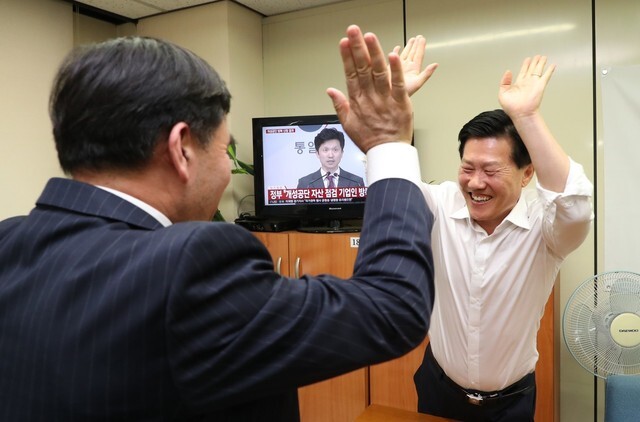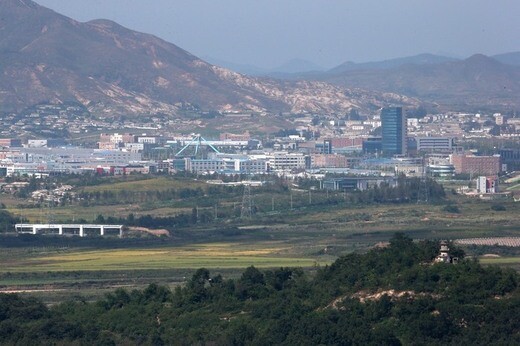hankyoreh
Links to other country sites 다른 나라 사이트 링크
S. Korean government finally grants approval to business owners to inspect assets in Kaesong Complex

In a surprise move, the South Korean government granted approval on May 17 for businesspeople at tenant companies to cross the border into North Korea and visit the Kaesong Industrial Complex, for the purpose of checking on their assets there. This will be the first time these businesspeople will be able to visit the complex and their factories there since the complex was closed in February 2016, three years and three months ago. Also, on Friday, the government decided to give US$8 million to the UN’s World Food Programme (WFP) and Children’s Fund (UNICEF) for use in humanitarian programs for North Korean children and pregnant women.
The announcement came after a meeting on Friday afternoon of the standing committee of the National Security Council (NSC), with Chung Eui-yong, director of the Blue House National Security Office, presiding.
“In the interest of protecting our citizens’ property rights, the government has decided to approve a request filed on Apr. 30 by businesspeople who have invested in the Kaesong Complex to visit North Korea and check on their assets. The government has also decided to help ensure that their visit takes place soon,” the government announced. This means that 193 businesspeople at tenant companies at the Kaesong Complex will probably soon be heading to North Korea, as they requested on Apr. 30.

The government’s decision is presumably aimed at greasing the wheels for inter-Korean dialogue and creating momentum that can lead to the resumption of North Korea-US negotiations, in the run-up to US President Donald Trump’s visit to South Korea at the end of June. Furthermore, the South Korean government has reportedly continued to explain in deliberations with the US that the businesspeople’s visit to inspect their assets cannot be delayed any longer because of the need to protect property rights. Considering that the businesspeople’s visit to the North is not in violation of sanctions and that it’s not a matter on which the US’ approval is required, the government appears to have concluded that there’s no reason to block the businesspeople from visiting once again.
US has no reason to oppose resumption of inter-Korean dialogue
Another apparent factor is that the US would have no reason to object to the South Korean government trying to find a way to resume inter-Korean and North Korea-US dialogue, which have both been deadlocked since the second North Korea-US summit, held in Hanoi in February, failed to produce a joint agreement. While the South Korean government had been planning to approve a similar request at the end of October 2018, it eventually shelved that plan in face of US opposition. Compared to that time, even the US appears to have walked back its insistence that the North must not be given any room to breathe.
“We’ve shared all of the necessary information with the US about letting the businesspeople visit the North to check on their assets, including the meaning, purpose, and nature of that visit. The US completely understands our position,” said Unification Ministry spokesperson Lee Sang-min.
Another matter discussed during the meeting of the NSC’s standing committee was the WFP’s findings about the food situation in North Korea. Following the discussion, the committee agreed to provide US$8 million, as requested by the WFP and UNICEF, for programs aimed at providing medical services and better nutrition to children and pregnant women.
“In regard to the issue of food aid to North Korea, we decided to review concrete plans, which could consist of aid through international organizations or direct aid by the government, while taking enough time to canvas the opinion of the public,” the committee also said.
Sources say that the government is seriously considering the option of providing food aid to North Korea in addition to the US$8 million that’s being given to benefit children and pregnant women.
Government still canvassing public opinion
“Providing US$8 million is intended to exorcise the trauma produced by the humanitarian aid whose timeframe expired [at the end of 2018]. We’re still open to the ideas of providing food aid through international bodies, through NGOS, or directly through the government,” said a senior official in the government who is familiar with the situation of humanitarian aid to North Korea.
The available methods of providing food aid to North Korea generally consist of giving funds to international bodies, creating a matching fund for the government and NGOs, and providing the aid directly. Before aid can be provided, the North Korean authorities must be contacted, and the method of aid must be determined based on the North’s response and the results of the government’s opinion canvassing. As such, a number of possibilities are still open.
“We’ll be thoroughly soliciting the public for its opinion on the issue of food aid to North Korea. We’ll continue to review the methods of providing aid through international organizations or providing it directly to North Korea,” the Unification Ministry spokesperson said on Friday.
According to a report on food security in North Korea recently published by the WFP and the UN’s Food and Agriculture Organization (FAO), the North is currently suffering a severe shortage of food, and these organizations are concerned that the food shortage will get even worse between July and September. The South Korean government will probably make an effort to ensure that the aid arrives before the end of that period.
By Noh Ji-won, staff reporter
Please direct comments or questions to [english@hani.co.kr]

Editorial・opinion
![[Column] Season 2 of special prosecutor probe may be coming to Korea soon [Column] Season 2 of special prosecutor probe may be coming to Korea soon](https://flexible.img.hani.co.kr/flexible/normal/500/300/imgdb/original/2024/0426/3317141030699447.jpg) [Column] Season 2 of special prosecutor probe may be coming to Korea soon
[Column] Season 2 of special prosecutor probe may be coming to Korea soon![[Column] Park Geun-hye déjà vu in Yoon Suk-yeol [Column] Park Geun-hye déjà vu in Yoon Suk-yeol](https://flexible.img.hani.co.kr/flexible/normal/500/300/imgdb/original/2024/0424/651713945113788.jpg) [Column] Park Geun-hye déjà vu in Yoon Suk-yeol
[Column] Park Geun-hye déjà vu in Yoon Suk-yeol- [Editorial] New weight of N. Korea’s nuclear threats makes dialogue all the more urgent
- [Guest essay] The real reason Korea’s new right wants to dub Rhee a founding father
- [Column] ‘Choson’: Is it time we start referring to N. Korea in its own terms?
- [Editorial] Japan’s rewriting of history with Korea has gone too far
- [Column] The president’s questionable capacity for dialogue
- [Column] Are chaebol firms just pizza pies for families to divvy up as they please?
- [Column] Has Korea, too, crossed the Rubicon on China?
- [Correspondent’s column] In Japan’s alliance with US, echoes of its past alliances with UK
Most viewed articles
- 1‘We must say no’: Seoul defense chief on Korean, USFK involvement in hypothetical Taiwan crisis
- 2Is Japan about to snatch control of Line messenger from Korea’s Naver?
- 3No good, very bad game for Korea puts it out of Olympics for first time since 1988
- 4Samsung subcontractor worker commits suicide from work stress
- 5[Editorial] Korea’s surprise Q1 growth requires objective assessment, not blind fanfare
- 6Division commander ordered troops to enter raging flood waters before Marine died, survivor says
- 7N. Korean delegation’s trip to Iran shows how Pyongyang is leveraging ties with Moscow
- 8Korea’s 1.3% growth in Q1 signals ‘textbook’ return to growth, says government
- 9Flying “new right” flag, Korea’s Yoon Suk-yeol charges toward ideological rule
- 10[Column] Park Geun-hye déjà vu in Yoon Suk-yeol